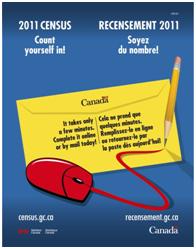Archived Content
Information identified as archived is provided for reference, research or recordkeeping purposes. It is not subject to the Government of Canada Web Standards and has not been altered or updated since it was archived. Please contact us to request a format other than those available.
Overview of the Census of Population
Chapter 3 – Communications
Table of contents
Introduction
The Census Communications Team, which is composed of staff in Ottawa and in each of the three regions (Eastern, Western, and Central), was responsible for providing communications support for the collection and the dissemination phases of the 2011 Census. The mandate of the Census Communications Team is to provide pro-active communications programs that are creative and cost-effective, while maintaining a positive, non-partisan, corporate image of Statistics Canada.
Messages
For the 2011 Census, communications materials focused on:
- informing respondents of the need to complete the questionnaire accurately and to return their questionnaires quickly
- encouraging respondents to complete their questionnaires online
- reassuring respondents that Statistics Canada protects their personal and confidential information (Statistics Act)
- reaching difficult to enumerate groups (young adults, immigrants, students, seniors, persons with an activity limitation) with a view to improving data quality and response rates
- supporting collection activities in the field by preparing materials that escalate the messages consistently with paid advertising and media relations
- increasing public awareness of the census (during collection and dissemination) by explaining its rationale and usefulness
- supporting recruitment initiatives.
Media relations
Media relations included editorial boards with newspapers and news magazines, and visits to media organizations. Media advisories were sent to all media to promote the census.
Public relations outreach
Statistics Canada's outreach strategy for the 2011 Census involved contacting thousands of organizations to solicit support for the census.
Potential supporters received e-mails or letters from the census manager or a regional director requesting support for the 2011 Census. In addition, community groups and local businesses and organizations with a specific clientele, or within a geographic area that was difficult to reach in other ways, were also contacted.
Paid advertising
Out-of-home advertising was placed in public locations such as bus shelters, on the outside of buses, subways, and billboards at the start of the drop-off/mail-out stage. Radio ads were also used to build awareness on the census. Advertisements were translated into several languages for ethnic print and broadcast media.
After Census Day, the messaging changed to a clear reminder that there was still time for people to send in a census form. Radio ads continued through June and July. During the last week of May, the message focused on calling the Census Help Line so that Statistics Canada staff could help respondents fill in their questionnaire over the phone.
Website
The census communications website was the primary response option for the 2011 Census. The website promoted the census, provided information and instructions for completing the questionnaires, and supported census recruitment.
Education
The 2011 Census Teacher's Kit comprised eight activities and a teacher's guide. Orders started in the spring of 2010 and the first mail-outs took place in September 2010. Copies were only mailed upon receipt of a specific order. Orders were filled as long as the kits were available (mid-May).
Promotional materials
Promotional materials for the 2011 Census were available free of charge. The poster, shown below, was an essential part of the census communications concept.

- Date modified: